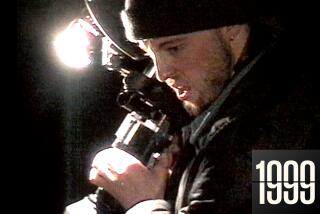The art of being vague
- Share via
The subway cars in New York are plastered with ads featuring cartoonish character faces with absolutely no hint about the advertisement’s purpose except for a come-on with the word Windorphins.
So what are Windorphins? A video game? A kiddie show? A sugary snack? A new drug to make you feel like your endorphins are kicking in?
None of the above. Windorphins is a new marketing gimmick for EBay, with ads so inscrutable as to be ridiculous. If the ads aroused enough curiosity for people to check out windorphins.com, some might have been disappointed to find that the mysterious windorphins (whatever those are) were simply a big tease.
But curiosity -- in the form of a riddle, a mystery, a puzzle, even a clever bit of deception -- is a powerful thing. Advertising has learned that teasing the public without giving too much away can be an effective marketing tool that can create a tremendous amount of excitement. Why? Because of our tremendous need to know.
This summer has offered great examples of glorious mysteries. A movie trailer shown with the opening of “Transformers” almost created more buzz than the big-budget movie itself. The mysterious trailer involved a hand-held video that showed a group of hip, young New Yorkers at a party, when suddenly they hear a loud noise, and the lights go out. The partygoers head to the roof of their building, only to see projectiles hurtling into buildings in Manhattan. Chaos ensues. A giant object rolls down the street. It’s the head of the Statue of Liberty. The trailer ends with a release date: Jan. 18, 2008. But no movie title.
It didn’t take long for movie geeks and Internet speedsters to create a big fuss over the trailer, which turned out to be a marketing campaign for a movie that is the work of J.J. Abrams, creator of “Lost” and “Alias.” The movie is going by the working name “Cloverfield,” although the Internet Movie Database (imdb.com) is calling it “Untitled J.J. Abrams Project.” In chats, it’s also being called “Slusho” and “Colossus.”
Whatever the name, the trailer worked because it created mystery and tension. Other examples of fanning a good mystery? The ending of the last “Harry Potter” book was both a literary sensation and a sensationally well-kept secret. And NBC teased viewers with an intentionally discombobulating commercial that asked, “What is Chuck’s secret?” and then a quick flash of discordant images. It ended by directing viewers to www.chuckssecret.com. The commercial was a come-on for a new show, “Chuck,” about the adventures of a hapless nerd whose brain is chuck-full of classified government secrets.
Another commercial for the new TNT show “Saving Grace,” starring Holly Hunter, was so oblique that viewers were left puzzled about the theme of the show. Another ghost whisperer, forensic chick or crime buster? Who knew?
These mysterious teases didn’t just have people scratching their heads; they had them talking.
“It’s all about creating buzz. Consumers are bombarded with 3,000 advertising messages a day. Advertisers are constantly looking for new ways to sneak under the radar,” said Don Carter, creative director for Adams & Knight Advertising and Public Relations in Avon, Conn. “With all the ways out there to advertise -- TV, newspaper, radio, billboards etc. -- word-of-mouth is often much more powerful. Designed to tease, these messages get people wondering and, hopefully, talking. The truth is you’re more likely to listen to and believe a co-worker or friend than a 30-second TV commercial.”
Carter points out that this type of marketing, which he calls guerrilla marketing, isn’t new. “For several decades now, the ad business has been looking for new ways to reach consumers,” he said. “Guerrilla marketing is often sneaky in its attack on consumers’ consciousness.”
But two decades ago, we didn’t have the Internet, which now has become the most effective way to plant and dissect the mysterious come-ons. The Internet was used to blockbuster effect to promote the mystery that was “The Blair Witch Project.”
Creating interest (and, therefore, creating brand awareness) by spurring people to voluntarily pass information to each other is called viral marketing.
And “Cloverfield” is a brilliant example of it. The hook of a mystery is, apparently, something we can’t resist. “We all want to know what’s behind the curtain and what’s around the corner,” said Richard Hanley, director of graduate programs in the School of Communications at Quinnipiac University.
Viral marketing will continue to work as long as the property has a good hook, Hanley said.
“A lot of creative energy is going into this area. At some point it will become saturated, and people will become inoculated to it,” he said. “We’re not there yet. People are still learning how this instrument called the Internet works. It’s still to be revealed.”
Like a good mystery.
More to Read
Only good movies
Get the Indie Focus newsletter, Mark Olsen's weekly guide to the world of cinema.
You may occasionally receive promotional content from the Los Angeles Times.










